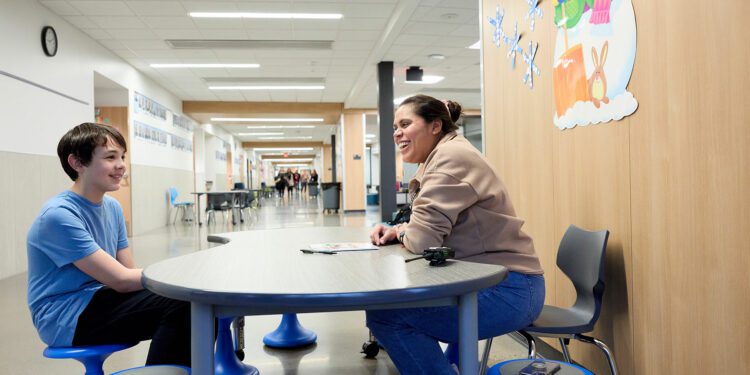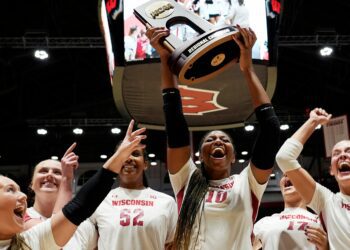Young adults in America are stressed out. A 2023 survey found that 67 percent of young millennials and 63 percent of Gen Z adults felt “consumed” by financial worries. Those surveyed, representing ages 18 to 34, cited money, the economy, and housing costs as major stressors. Meanwhile, young families are fleeing the United States’ largest cities, building on a 2022 trend that saw 25 percent of millennials moving to midsize cities. This begs the question: How can young Americans lead better lives, and where can they do it?
Enter Minnesota, the least stressed state in America, according to an average of 40 indicators, including hours worked per week, housing affordability, and financial anxiety. Minnesota, with its reputation as a humble Midwestern state, may seem a surprising solution to young adults’ anxieties. But the so-called Star of the North is uniquely positioned to meet newcomers’ and transplants’ needs as they continue to seek inclusive locales with higher standards of living compared to larger, coastal metropolises.
First and foremost, Minnesota is a place where one can live well; it’s ranked number four in the U.S. for quality of life as well as happiness. It’s also home to forward-looking industries and career opportunities, with more than a dozen Fortune 500 companies as well as fast-growing small businesses and start-ups. If you ask Lauren Bennett McGinty, a lifelong Midwesterner based in Minneapolis, how the state balances its high quality of life and business interests, she’ll tell you that the two go hand in hand.
“Innovation is sparked when people are excited to go to work every day. You’re probably not excited to go to work every day if you live in poor conditions,” says Bennett McGinty, the executive director of Explore Minnesota. The state’s entrepreneurial spirit (it’s the birthplace of Rollerblades and waterskiing) is bolstered by investment in its people. “We care both about the business and the employee,” says Bennett McGinty. “It’s not one or the other in Minnesota, and that makes a huge difference when you’re trying to attract talent.”
 Minnesota invests heavily in K-12 programs, fostering a spirit of community engagement. Source: Explore Minnesota
Minnesota invests heavily in K-12 programs, fostering a spirit of community engagement. Source: Explore Minnesota
That investment in people begins with early education and continues through early career opportunities. Minnesota provides free breakfast and lunch to all schoolchildren, as well as postsecondary enrollment options to high school students so they can earn free college credit. Minnesota also recently removed the job qualification of a bachelor’s degree from two-thirds of its state office positions. “That’s an indication that our state really values training on the job and learning as you go,” says Bennett McGinty.
This sentiment is echoed by Shannon Bryant, a recent transplant to Minnesota who heads workforce and economic development for the colleges and universities of Minnesota State. She notes that a key element of any state’s economic success is supporting its local talent pool: in other words, investing in people’s well-being and future. “You can’t do things if you don’t have resources,” says Bryant, “and there’s a plethora of resources here.”
Minnesota State’s educational institutions work closely with local industries to build career pathways for students. The investment across its 26 community colleges and seven state universities is all about residents’ quality of life. “At the end of the day, we’re about the people,” says Bryant. She notes that it’s not as simple as lining up job opportunities; rather, she works with her counterparts in the business sector to develop programs that train the workforce for existing opportunities, all while ensuring that career ladders exist for people to advance in these roles.
Minnesota makes sure that all people have access to jobs, ways to raise their families, as well as world-class healthcare.Shannon Bryant, Executive Director, Explore Minnesota
Minnesota State’s offerings, which include certificates and noncredit programs in key local industries, such as STEM-related fields and manufacturing, also help nontraditional learners who are pursuing a career change. “We can come up with long-term solutions for our students that lead to economic prosperity for both them and their families,” says Bryant. “That sustainability provides economic prosperity, because businesses can stay if they know they have a workforce.”
Take Microbiologics, a business founded more than 50 years ago by an entrepreneur in St. Cloud, Minnesota, located about an hour outside of St. Paul. Originally a water testing facility, it’s grown into a company that creates quality controls for food, cosmetic, and medical industry testing. Today it employs 240 people, with about 170 based out of its St. Cloud headquarters. It maintains close relationships with science departments at local universities to help students develop their career paths, while recruiting out-of-state employees who recognize the state’s high standard of living and opportunities for career growth.
Mardi Noyes, the vice president of human resources at Microbiologics, sees the company’s trajectory as a reflection of what businesses are capable of achieving in Minnesota. Noyes gives significant credit to the state’s investment in K-12 programs, its support for immigrant families, and its spirit of community engagement. “There’s been such a focus on education and things that lead to ground-breaking industry,” observes Noyes. “The history of Microbiologics—starting in water treatment, recognizing a problem that needed to be solved, and innovating to solve that problem in multiple industries—that’s a really normal process in Minnesota. There’s something special here, and companies, especially in the biotech or life science world, are brave enough to have missions.”
That community-minded approach is central to Minnesotans’ lives. The state has among the highest rates of volunteerism in the U.S. (41 percent of its population in 2019) and is home to many immigrants and refugees, including Hmong, Mexican, and Somali people. “Minnesota makes sure that all people have access to jobs, ways to raise their families, as well as world-class health care,” says Bennett McGinty.
Over the course of her first year in Minnesota, Bryant has seen this welcoming ethos in action. “To be able to come here and have that small-town feel with the acceptance of diversity is a big thing,” she says. She also points to the New Americans program and the Minnesota Indigenous Workforce Initiative as examples of the state’s efforts to build economic prosperity in partnership with communities while meeting their cultural needs.
 Minnesota is the land of 10,000 lakes—which residents enjoy year round—and ranked number two among U.S. states for its natural environment. Source: Explore Minnesota
Minnesota is the land of 10,000 lakes—which residents enjoy year round—and ranked number two among U.S. states for its natural environment. Source: Explore Minnesota
For Kat, a millennial and glass artist who previously lived in Chicago, moving to Minnesota was affirming in part because of the state’s emphasis on inclusion. “I think what’s exciting about being in Minneapolis is the cultural diversity,” says Kat. “My indigenous heritage is the Eastern Band of Cherokee Indians. For my people, it’s about your connection to the land.” Moving to Minnesota not only provided Kat and her husband, Josh, with job opportunities (they work at Hennepin Made, a company that makes hand-blown glass lighting) but also gave them access to the outdoors and the time to enjoy it.
Indeed, Minnesota, also known as the land of 10,000 lakes, is ranked number two among U.S. states for its natural environment. The state is also taking strides to protect these areas. “Minnesota is so proud of our four seasons. Being able to keep our beautiful natural spaces for generations to come is really important,” says Bennett McGinty. To that end, the state government has made efforts to remove PFAS chemicals from its water and is focused on climate resiliency projects. “We’re investing in programs that improve people’s quality of life,” says Bennett McGinty.
For millennials in search of opportunity—particularly workers under 35, who reported a decline in their well-being in 2023—moving to the Star of the North could be an answer to stress, financial anxiety, and lack of community. “This overall sense of community is very different from a lot of places we’ve been,” says Kat. “Not only are you getting out in nature, but you have such a thriving city life, too.”
Josh notes that, without this move, they wouldn’t be where they are today: homeowners, married, and planning out the next five years of their life. “Moving to Minnesota opened up a lot of doors for us,” he says. “We got to purchase a house last year. We got to not work weekends, which we’ve never done in our entire life. Our jobs created a ton of stability for us.” The couple now has “time to focus on work and us at the same time,” achieving the elusive work-life balance that so many seek.
Kat puts it simply: “[Minnesotans] want a good quality of life,” she says. “That’s something that we always wanted. We’ve finally found that.”
Learn more at ExploreMinnesota.com
Source link : http://www.bing.com/news/apiclick.aspx?ref=FexRss&aid=&tid=66e4a35f33a0491a8f41274d68bd27a0&url=https%3A%2F%2Fwww.theatlantic.com%2Fsponsored%2Fexplore-minnesota-2024%2Fthe-case-for-moving-to-minnesota%2F3925%2F&c=15784993681672946063&mkt=en-us
Author :
Publish date : 2024-09-13 09:12:00
Copyright for syndicated content belongs to the linked Source.




